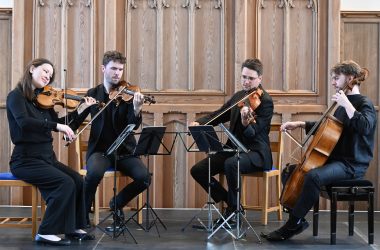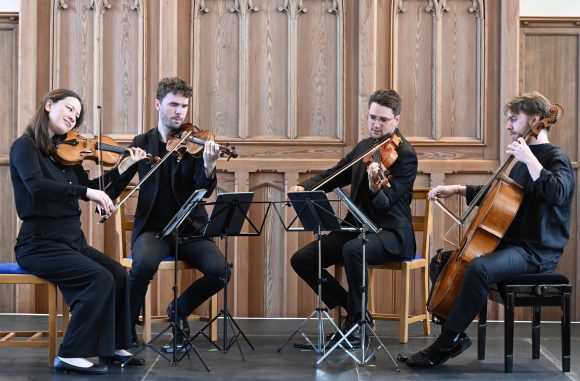
 United Kingdom Various, East Neuk Festival 2024 [2]: (SRT)
United Kingdom Various, East Neuk Festival 2024 [2]: (SRT)

28.6.2024 – Opus13 (Sonoko Miriam Welde, Violin Edvard Erdal [violin], Albin Uusijärvi [viola], Daniel Thorell [cello]), Kilrenny Church
Caroline Shaw – Entr’acte
Beethoven – Quartet in B-flat Op.13 with Grosse Fuge
29.6.2024 – Opus13, Crail Church
Grieg – Quartet in G minor, Op.27
30.6.2024 – Opus13, Julian Biss (clarinet), Elie Church
Andrea Tarrodi – Madárdal (Quartet No.2)
Mozart – Clarinet Quintet in A, K.581
30.6.2024 – Scottish Chamber Orchestra / Maxim Emelyanychev (piano/conductor), Bowhouse, St Monans
Mozart = Piano Concerto No.22 in E-flat, K.482
Beethoven – Symphony No.7 in A
Every year the East Neuk Festival manages, slightly implausibly, to bring some of the biggest hitters in chamber music to a sleepy corner of East Fife that is tucked away from the rest of the world. But the festival also showcases newcomers, and one of the great skills of the festival’s director, Svend McEwan-Brown, is to spot rising stars on the way up and give them a platform. Hence on the Friday evening of this year’s festival, the East Neuk’s audiences could hear chamber music royalty and regular festival guests, the Pavel Haas Quartet and pianist Boris Giltburg playing a predictably brilliant programme of Brahms and Tchaikovsky.
However, by far the biggest discovery of the festival this year, for me, was Swedish Norwegian string quartet Opus13, whose several concerts made a first impression that I will not forget in a hurry. For one thing, they played with sensationally rich tone, supported by the acoustic of the little church in Kilrenny which hosted their first concert, and which might as well have been designed to support a string quartet. The main work in that programme was Beethoven’s mighty B-flat Op.130 Quartet, ending with the Grosse Fuge, and Beethoven’s quietly introspective opening lent itself beautifully to Opus13’s richly focused sound. The players leaned into one another in a way that milked every drop of beauty from those opening phrases, laying the groundwork for a Cavatina of honeyed warmth and calmly flowing spiritual intensity.
What was really striking about their playing of it, though, was how playful so much of the music sounded. This quartet contains so many mysteries and questions whether it is as good a way of answering them as any, and the main Allegro of the first movement seemed to dance along rather than announce itself from the mountain top. All of the middle movements had a twinkle and a sparkle to them, the slow third movement just as much as the spidery second movement and the heel-kicking German dance. In fact, if you hadn’t been told, then you would scarcely have realised you were listening to one of the great, granite masterpieces of western music.
Until you got to the last movement, of course. Stravinsky famously described the Grosse Fuge as ‘eternally contemporary’, but I sometimes think ‘eternally baffling’ might have been a better quip. In fairness to these young musicians, they refused to let themselves be intimidated by it. Instead, they tore with abandon into the opening unisons, and their bows dug into the lines of the fugue in a way that gave the music real teeth. The muscular vigour of their playing always seemed to have another stop to pull out, but there were flashes of sweetness too and even, if you knew how to listen for it, some of that earlier playfulness.
There wasn’t so much playfulness to their companion piece, but Caroline Shaw’s tremulously beautiful Entr’acte didn’t need it. Instead, it seemed to have a deep spiritual sense that almost shuddered as it was played. Shaw does a lot with a little, creating tonally appealing music out of just a few fragments, not unlike the holy minimalism you would associate with Arvo Pärt, but reimagined for the digital age. So cleverly did Opus13 shape the sound that you could have been tricked into thinking that it had been electronically manipulated, even though it definitely wasn’t: the way the lines of the central section melted messily into the return of the opening was proof enough of that.
On Saturday evening Opus13 performed Grieg’s completed quartet with livewire energy that seemed to shoot a bolt of lightning through it. The mood of tempestuous energy characterised even the dark-hued central movements, and didn’t really lift, even through the final Saltarello. Yet every so often they could make the clouds part, most notably in a sensationally lovely effect at the end of the first movement when Daniel Thorell’s cello sang out the most gorgeous lyrical melody while the other instruments played a quietly shuddering tremolo. Throughout, each aching suspension, every lingering harmony was invested with incredible meaning and the feeling that the quartet’s textures were being illuminated rather than merely driven.
And on Sunday morning they did a terrific job with Andrea Tarrodi’s Madárdal, a piece which, like Shaw’s Entr’acte was built out of twittering shards of melody repeated, layered, contrasted and melded. The second half of the quartet unfolded its slow-moving music like tendrils of sound through the still air of Elie Church, sounding completely hypnotic. Opus13 were later joined by clarinettist Julian Biss in a beautifully upbeat performance of Mozart’s Clarinet Quintet. The quartet provided gentle support for Biss as he gently spun out the gorgeous long lines of the slow movement, while the second Trio of the Menuet had all the swing of a bucolic Ländler. Each player had their chance to shine individually in the jolly variations of the finale, and everyone looked like they were having a whale of a time. Sounded like it, too.
If Opus13 were my big discovery of the festival then the Scottish Chamber Orchestra provided more predictable treats. They are the East Neuk Festival’s strongest thread of continuity, appearing in every one of the festival’s twenty years, and their programme of Mozart and Beethoven packed out the Bowhouse, a big warehouse that serves as a farmer’s market on the main coastal road. It just about works as a concert hall, though it gives the music an unusually specific sense of location. You never feel that the sound is anywhere other than at the front of the hall: there is no bloom or any sense that the acoustic is carrying the sound to your ear. There is nothing necessarily wrong with that, though, and it does have the big advantage of clarity, something that reaped dividends in their take on Beethoven’s Symphony No.7, which really let the natural brass and timps let rip.
That is something that conductor Maxim Emelyanychev loves to do, and there are normally unexpected treats in store when he acts as a concerto soloist, too. Those came through in Mozart’s celebratory PIano Concerto No.22, particularly in the cadenzas, which had a strong feel of being made up on the spot. If that brought excitement to the outer movements then it didn’t bring so many advantages to the slow movement, one of Mozart’s most poignantly heartfelt utterances, which here felt like it was being pulled in several directions at once. Fluctuations in tempi and even some slightly ragged coordination between keyboard and orchestra meant that Mozart’s gorgeous sense of meditation was interrupted by some clever-clever interpretative touches, which might have worked in the faster movements, but not so much here. Still, the upbeat jollity of the finale swept all before it, and Emelyanychev even managed to give it space to breathe in its slow Menuet-like interlude.
Simon Thompson
